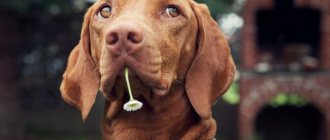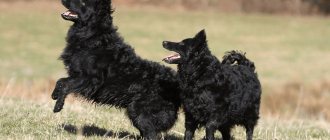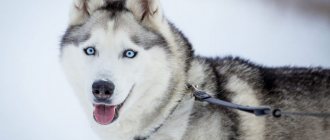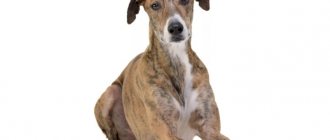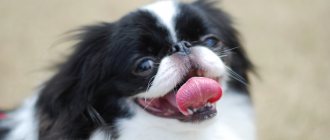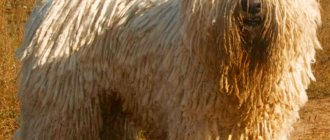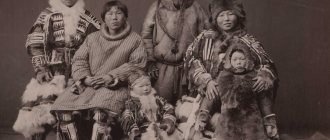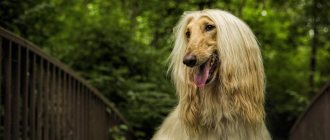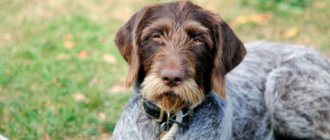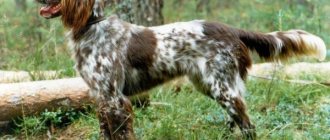Breed characteristics
| Short description | |
| Origin: | Hungary |
| Conditions of detention: | House, local area |
| Purpose: | Hunting dog, companion |
| Color: | Red-golden, red |
| Wool length: | Short, smooth coat or medium-length harsh coat |
| Adult dog size: | The height of the female is 54-60 cm, the male is 58-64; male weight – 25-27 kg, female – 20-25 kg |
| Average life expectancy: | 12-14 years old |
| Walk: | A long walk twice a day is required, even when kept on the street. |
| Physical activity needs: | High physical activity needs (hunting, jogging, swimming) |
| Fédération Cynologique Internationale (FIC) classification: | Group 7: cops; section: continental pointers |
| Puppy price: | From 42,000 rubles to 80,000 rubles. Pet class – up to 45,000 rubles, breed class – up to 60,000 rubles, show class – 70,000-80,000 rubles. |
History of the Hungarian Vizsla breed
The history of four-legged hunters began in the 9th-11th centuries, when their ancestors - pointing dogs - first appeared on the territory of Hungary.
At that time, the country had not yet gained autonomy and was part of Pannonia, a Roman province where the climate was damp and unsuitable for comfortable living. This territory became home to the Magyars, whose main occupation was hunting. To bait game, the nomads bred sandy-colored dogs that had excellent terrain awareness and were adapted to the weather conditions of Pannonia. Like the Magyars, these animals were distinguished by a love of freedom, so they often left their homes and spread throughout the province. Cops that migrated to neighboring regions remained invisible against the backdrop of indigenous and already established breeds.
It is not known what the fate of the Magyar dogs would have been if they had not attracted the attention of Hungarian hunters with their grace and dexterity. To improve their working qualities, the animals were crossed with cops of eastern origin. The appearance of the dogs also changed: thanks to mating with Russian greyhounds, their coat acquired a lighter shade. In the first half of the 16th century, future Vizslas were influenced by the Salukis, sand greyhounds that accompanied Turkish troops during the occupation of Hungary in 1526.
Purposeful and random matings led to an amazing result - the appearance of golden hunting dogs with an established genotype. They were highly valued by the Hungarian nobles, who used the animals in baiting fur-bearing animals or birds. The ancestors of the Vizslas were considered universal hunters who coped with work in the forest or field and fearlessly threw themselves into the water after wounded game.
In addition to their excellent hunting and falconry abilities, the dogs were notable for their energetic intelligence and spectacular appearance. The amber color not only pleased the eye, but also played an important role. Thanks to its noticeable “fur coat,” the Vizsla stood out against the background of the landscape, being at a considerable distance. At the same time, pointers with a reddish tint of fur took part in falconry, while in forest hunting - with golden ones. Subsequently, the two lines of the breed mixed with each other.
Animal selection was brought under careful control in the 18th century. The initiator of the development of a new breeding program was a breeder named Zai. Under his leadership, in the Hungarian city of Zaingroc, work began to improve the parameters of short-haired pointers, which took more than 150 years. Hanoverian hounds, pointers, shorthaired pointers and even poodles have become promising “material” for mating. As a result of selection, it was possible to improve the exterior and field qualities of the Hungarian Vizsla - the future national treasure of the country.
In the 19th century, golden hunting dogs became less popular, losing leadership to German pointers. In order to preserve the breed, the import of pointers from Europe was banned until 1880. With the disappearance of the “canine barrier”, the mass import of pointers to Hungary was resumed. The efforts of the breeder Zaya and his followers were in vain. Now the existence of short-haired cops was remembered only by their ardent lovers, who continued to keep the dogs. From these few purebred Vizslas the modern line of the breed originated. In most pedigrees you can find a mention of a bitch named Kati or a native of the Nimrod kennel.
Hungarian Vizslas were increasingly found in European countries, as well as in Canada and the USA. Active export of dogs to America began after 1935, when representatives of the Fédération Cynologique Internationale (FCI) entered the breed into the official register and approved its standard. US cynologists actively took up the selection of Vizslas and soon increased their numbers, thereby protecting them from complete extinction. Although pointers were attracted by their greater endurance, Hungarian pointers were distinguished by their ability to hunt in any terrain - both on land and in water.
Despite the measures taken, the number of Vizslas decreased significantly with the outbreak of World War II. Freed from the yoke of fascism, the Hungarians were guided by hopelessness and fear, which is why they made the cruel decision to kill all the dogs so that they would not become a war trophy for soldiers. Fortunately, the animals were partially preserved in neighboring countries, from where they began to conquer the globe.
The name of the breed comes from the Hungarian word vizsgál, which means “to analyze, search, study.” Indeed: these dogs have an amazing ability to find prey even in dense thickets. Now Hungarian Vizslas are rarely used for their intended purpose, but the animals still managed to win the love of dog handlers around the world thanks to their docile nature and ability to become an indispensable companion.
History of the origin of the species
Dogs appeared back in the 10th century, they came to the mainland along with the nomadic Magyars, who hunted for survival. Later, the nomads settled in the region where Hungary is now located, became townspeople, and later - aristocrats. Thus the Vizsla became a breed of nobility.
"Vizsla" means "to seek" in Hungarian.
The dogs were crossed with local pointers and gundogs, which resulted in a short, shiny coat and impeccable working qualities. The law prohibited exporting the Vizsla abroad, because the breed was considered the property of the country.
Official breeding of dogs began in the 20s of the 20th century, when dog handlers tried to save the Hungarian Pointer from extinction. The standard was awarded to the breed in 1936. And a little later, the wirehaired Hungarian Vizsla was created (by mixing with the German Wirehaired Pointer). But this breed is registered separately.
Hungarian Vizsla price
The price of Hungarian Pointer puppies is determined by several factors:
- location and popularity of the nursery;
- class of the dog - for participation in exhibitions (shows), breeding (breeding) or keeping as a pet (pet);
- characteristics of the animal (including compliance with the breed standard);
- awards and titles from parents.
The average cost of a Hungarian Vizsla varies from 10,000 to 40,000 rubles. Dogs with an elite pedigree can cost owners more money, while animals with defects cost less. People from the poultry market are attracted by their low price, but there is a high risk of buying a non-purebred dog with a weakened immune system. You should not spare money on your future companion, because the joyful moments that communication with a Hungarian Vizsla will give are priceless!
Distinctive features
The Vizsla is a lean, medium-sized dog, reaching 54-64 cm at the withers and weighing up to 27 kg. The breed is characterized by a streamlined, dry body, long limbs, and a proud carriage of the head. We can say that the Cops look aristocratic.
- Head with a dry skull, moderately wide between the ears. Cheekbones and brow ridges are clearly visible.
- The muzzle is square with a straight bridge of the nose. The jaws are strong, have a scissor bite, and have a full set of teeth. The lips are slightly jagged.
- The nose is large and reddish brown.
- The eyes are small, almond-shaped, brown or dark in color.
- The ears are long, round, set low, and fit tightly to the head.
- The body is rectangular, dry, strong. The topline is slightly sloping. The croup is rounded. The neck is long, moderately thick. The belly is tucked in. The chest is of medium volume.
- The tail is long, thin, set low, saber-shaped.
- The limbs are straight, long, strong with well-developed muscles. Paws are rounded.
- The coat is double-layered and lies tightly to the skin.
- Color – red-golden, red-brown.
Description
After we have learned a little about the origin of these dogs, let's now find out the description of the Hungarian Vizsla breed.
The body is of medium length. The chest is rounded, which gives the dog a noble appearance. The back has a massive and menacing appearance, their back muscles are well developed.
The limbs are correctly shaped, slender and straight. The muscles are clearly visible. This is especially evident when the dog’s paws are gathered side by side.
The tail is large, but towards its end it tapers.
Beautiful muzzle with very expressive shapes. Small eyes with a raised outer corner. The ears are thin and set low.
Photo of an adult dog
Photos of puppies
Features of character and behavior
The Hungarian Vizsla is not your typical hunting dog. The breed is friendly to others. The animal gets along well with all strangers, never gets into conflicts, and does not “quarrel” even with cats and small rodents. The cop loves children, will play with them, but is unlikely to protect them from an enemy, because for this dog there are no bad people.
The Vizsla is very active, tireless, and hardy . She is ready to hunt all day long without feeling overtired. Animals have well-developed intellect and instinct; from birth they have all the necessary skills for work (stand up, follow the scent).
Another feature of the Hungarian Pointer is its attachment to humans. A dog cannot live without its owner for even a minute. She constantly needs contact with her family.
Nutrition
Feeding is organized on simple principles. Always and everywhere food is a blessing that must be treated with respect. When moving away from the bowl, the remaining food is removed. There should be no intermediate snacks between feedings. You can’t feed him food from the owner’s table.
When compiling a diet, you need to take into account that the Hungarian Pointing Vizsla is a hunting dog. Even if she never heard the sound of a gunshot. The diet of hunters is similar to that of athletes. There can be two strategies:
- nutrition with natural products,
- use of dry food.
Dog trainers often recommend choosing natural products. From many veterinarians you can hear recommendations for the use of dry ready-made food. Natural nutrition usually contains a lot of protein foods with the addition of vegetables, without including cereals. Dry food makes the owner's life easier. They are easy to match to the age and breed of the dog.
Advantages
Owners of Hungarian Coppers dote on their pets. How can you not love such loyal and intelligent animals? Breeders boldly declare the main advantages of the breed:
- Sociability, lack of aggression, friendliness to people and animals;
- Love for children;
- Mobility, energy;
- Balance, calmness;
- Sensitivity (the dog senses emotional fluctuations, knows when to approach the owner and when not to);
- Unobtrusiveness;
- Loving nature;
- Developed intelligence and quick learner.
Pros and cons of the breed
The Hungarian Pointer is a universal hunting dog with its own advantages and disadvantages, which are better to get acquainted with before making the final decision to buy a puppy.
| pros | Minuses |
| Interesting appearance | Intolerance of loneliness |
| Balanced psyche | Lack of undercoat |
| High efficiency |
The Hungarian Pointer is a long-eared, short-haired dog with a noble bearing and bright color. A born hunter with a friendly character will become a faithful assistant to those who lead an active lifestyle and are often outdoors.
Care and maintenance
The Vizsla is a fairly large dog, which is simply inconvenient to keep in an apartment. But Cop doesn’t care what conditions he lives in, the main thing is to be close to a person. After all, animals have worked side by side with people since ancient times.
It is better for the Hungarian Vizsla to be in a large country house with free access to the street . The breed is not suitable for chains or kennels. Keeping in a kennel is acceptable provided there is frequent contact with the family and the ability to enter the house at any time.
Such a pet does not require special conditions and careful care. But it needs frequent long walks and constant attention from household members. Before buying a dog, it is important to purchase a heated bed or kennel (you can build it yourself), height-adjustable bowls, toys, a collar and a leash.
Nutrition
Cops are not picky. They will eat what they are used to from puppyhood.
- Babies up to 1.5 months are fed by the mother, later complementary foods are introduced in the form of milk porridges.
- At 2-2.5 months it is already allowed to give grated boiled meat and baked apples.
- From 3 months it is possible to switch to baby dry food (must be softened with water or kefir before serving).
Ready-made food makes keeping a dog much easier. The products do not need to be boiled or diluted additionally, just determine the serving size. Moreover, high-quality food contains the necessary complex of vitamins and minerals, so there is no need to worry about balancing the diet.
Any super-premium class food for active breeds (or hunting breeds) of medium and large sizes is suitable. It is important that the composition does not contain dyes, preservatives, flavor enhancers, corn or wheat. Meat should come first (from 35%).
Dry food is convenient due to its variety. You can choose a product for puppies, pregnant females, sick and elderly dogs, and allergy sufferers.
Natural food is more difficult to prepare, but it is often cheaper than complex feed. It will not be possible to achieve a complete balance of microelements, so you will have to introduce vitamin supplements.
- A serving should consist of 40% meat: chicken, beef, turkey, rabbit.
- Other proteins will also work: kefir, cottage cheese, sea fish, eggs.
- Carbohydrates – buckwheat, oatmeal and rice, cooked in water.
- Fats – fish, including Omega-3, and vegetable oils (linseed or olive).
- It is useful to add raw or boiled vegetables (carrots, beets) and fruits (apple, pear).
The serving size depends on the age and weight of the dog. Up to a year, puppies are fed 3-5 times, 200-250 grams. Adult pets – 2 times a day, 400-600 grams.
Prohibited foods include bones, potatoes, flour and confectionery products, onions and garlic, tea, alcohol, fatty, fried, butter and pork. It is not recommended to give milk to dogs older than 3 months.
We recommend that you read a detailed article on the topic: “How and what to feed a dog: types and characteristics of nutrition.”
Health
The Hungarian Vizsla can be called a strong dog. With its rather large size, the Pointer lives up to 1 2-13 years , and with proper care - up to 15-16 . The main thing is to follow the training regime, feed your pet properly, take it to the veterinary clinic for examinations every 5-6 months and get vaccinations according to age.
Vaccinations
Hunting breeds need timely vaccination more than others. Instinct guides even an untrained dog. Vizslas often bring killed game found in the plantings or bushes near the house.
Contact with wild animals and birds increases the risk of infection with dangerous viruses that the immune system cannot cope with.
- The club that sells the puppies is responsible for the first vaccination But private breeders rarely vaccinate newborns, so it is better for the owner to find out whether the procedure was carried out.
- According to the schedule, the first injection should be given at 2.5 months, when the puppy’s immunity ceases to be fueled by the mother’s immune cells obtained from breast milk. Inactive strains of parainfluenza, adenovirus, enteritis, hepatitis and distemper are introduced.
- After a couple of weeks, the procedure is repeated and strains of leptospirosis are added to the serum.
- At 7 months they are vaccinated against rabies, at 12 months all vaccinations done previously are repeated.
- Annual revaccination is required, the duration of the drugs is designed for 12-20 months . After this period, the strains cease to act and the dog’s immune system “loses its vigilance.”
Important article on the topic: “Everything you need to know about dog vaccinations.”
The above vaccinations are considered mandatory. Without them, the dog cannot be walked in public places, transported across the border, or knitted. There are also additional vaccinations against piroplasmosis and lichen. The owner can give them to the pet at will, for example, at a time of exacerbation of diseases in the region.
On the day of vaccination, the dog must be healthy. Therefore, 2 weeks before the procedure, cleansing of helminths and ectoparasites is carried out. Lethargic animals with fever and other symptoms are not allowed for vaccination.
Diseases
Breeders try to cull individuals with hereditary (congenital or manifest) diseases. However, genetic health problems occur in 40% of cops. The following diseases are most often diagnosed in the breed:
- Oncology;
- Hypothyroidism (thyroid dysfunction);
- Hip dysplasia;
- Glaucoma and cataracts;
- Retinal atrophy;
- Atopic dermatitis;
- Poor blood clotting (hemophilia);
- Von Willebrand's disease (as progressive hemophilia).
Walk
Walking is vital for the breed . Even if the dog lives outside in a kennel or enclosure and walks freely around the yard, it is imperative to take him outside a limited area (into the forest, planting, field, dog park).
You need to run a lot. An owner who is not a hunter can give the pet a chase after a mechanical hare. Cops like to chase a ball and go through an agility course. Such a four-legged friend will share any sports hobbies: swimming, cycling or rollerblading, tennis.
On average, an adult Hungarian Pointer requires 2 walks (morning and evening) for 2-3 hours. Puppies are walked 3-4 times a day for 40-80 minutes.
Grooming
These dogs require virtually no grooming. Their short coat is considered hypoallergenic, although they shed twice a year. Brush it once every 2 weeks with a glove brush. During the seasonal coat change period, it is better to wipe the dog with a fleecy cloth every 10 days.
are bathed once a month with gentle detergents. In the summer, dogs can and should be taken to natural bodies of water so that they can rinse off and swim to their heart's content. Be sure to wash your paws after every walk.
The breed has a weak spot – the ears. Due to the hanging position, the ear canal is not ventilated, moisture accumulates there, and pathogens multiply. You can prevent the development of otitis media if you inspect your pet’s ears daily and clean them of wax accumulations.
The nails of hunting breeds are rarely trimmed, but if the dog is kept in a house or apartment, the plates do not wear off by friction against the asphalt. Then you need to shorten them every month. Teeth are brushed every week. You can use traditional tools (a brush and dog toothpaste), rubber toys with bristles, or chewing sticks.
Possible diseases
After walks, you should inspect your dog's paws. If cuts are found, they are treated with hydrogen peroxide. The cracks are lubricated with vegetable oil. In winter, after walking, be sure to wash off the chemical reagents that are sprinkled on city streets from your paws. Otherwise, the reagents will corrode the skin on the paws.
To prevent tartar, use a special toothpaste, which is applied with a brush or a finger tip. If redness or pus appears in the eyes, contact your veterinarian.
Only he can determine whether it is an injury, a bacterial infection or an allergic reaction. You should not self-medicate sore eyes. For prevention, you can wipe your healthy eyes with chamomile decoction once a week.
Clean your ears once a week with a cotton pad. The appearance of an unpleasant odor from the ears, the appearance of pimples indicate a disease or ear mites, as well as restless shaking of the head and scratching of the ears with the paws.
To avoid the appearance of ticks, lice or fleas, the wool is treated with special means, not only upon detection, but also for preventive purposes. Special products are available in the form of sprays, drops on the withers, injections, tablets and collars. Diseases characteristic of Vizsas: epilepsy, food allergies, hypothyroidism, hip dysplasia, cancer, retinal atrophy.
Mating
Hungarian Vizslas are rare hunting dogs for which it is important to preserve their working skills in their natural state, therefore all matings must be official, club, sealed by an agreement. To ensure a high-quality litter, breeders make pairs of opposite dogs that complement each other’s strengths and weaknesses.
Large dogs require the intervention of a professional in mating. It is not so easy to help them, because you need to keep the female and male in one position for 15-20 minutes while the “lock” lasts. Vizslas are quite heavy, so the strength of both owners and the dog handler will be needed.
Pets are untied at 2 years old, then the maturation stage is completed, dogs are able to conceive, bear and give birth to healthy offspring. The female is brought to the territory of the male; you can walk the animals in advance and introduce them. On average, the act lasts 20-30 minutes.
Read a detailed article on the topic: “Everything you need to know about breeding dogs: appropriate age, what to do if it doesn’t work out, rules and tips.”
Psychology
The Hungarian Vizsla, whose photo speaks for itself, is very active and mobile. This graceful dog has an athletic build and a sweet character.
- Mental capacity. The Hungarian Vizsla breed is recognized as one of the smartest dogs, which undoubtedly helps it in hunting. In everyday life, this affects quick learning and good upbringing.
- Activity. A good hunting dog should be playful, agile and active. On the street, the Vizsla, like a Russian greyhound, does not sit idle for a minute; she tries to devote all her free time to physical exercise.
- Devotion. The Hungarian Vizsla is devoted to its owners. He always chooses one family member, whom he considers the leader of the pack and respects infinitely.
- Vigilance. The dog will raise the whole house to its feet if it notices an uninvited guest. Thanks to its vigilance, the Vizsla, like the Schipperke, can also be a good watchman.
- Friendliness. The Vizsla is a sociable, friendly and good-natured dog who will certainly find a common language with children. This dog can even get along with cats.
A good hunting dog should be playful, agile and active. The Vizsla does not sit idle for a minute on the street; she tries to devote all her free time to physical exercise.
- Endurance. The Hungarian Pointer tolerates various weather conditions well and can withstand long walks, which is indispensable for hunting. It can also accompany you on a hike.
- Calm. Unlike on the street, in the house the dog behaves quietly and unnoticed. The Vizsla captivates with its calm and easy-going character.
- The need for socialization. You need to train and educate a dog from childhood; if you start this process, it will be difficult to retrain the dog.
- "Ruminant". The Vizsla loves to chew on something all the time. It’s better to stock up on soft and rubber toys than to regret later about ruining your favorite shoes.
The Hungarian Vizsla shows itself at its best in hunting on land and water
Key points in training
The Hungarian Vizsla is a highly intelligent dog, it learns quickly and does not strive for leadership in tandem with its owner. The cop is obedient, especially if raised from childhood . It’s easy to get her interested in play training. It is better to motivate the Vizsla with toys; goodies are also suitable, but balls, rings and other attributes will be a real joy for the dog.
It is not necessary to train the Cop to hunt; she has innate skills in finding and catching game. But special training will further reveal the animal’s potential.
The Vizsla puppy is kept indoors for up to 3 months. At this time, you can give your baby all the basic rules of behavior. The dog must know the feeding and walking schedule and follow the regime. The pet needs to learn its name, basic commands (“sit”, “lie down”, “no”, “place”, “next to me”, “to me”).
Read about how to properly train a dog in the article: “Training a puppy: effective methods from dog handlers, learning commands at home.”
How to deliver a dog yourself
Childbirth takes place approximately 2 months after mating. Delivery should be carried out under the supervision of a qualified specialist.
If you had to give birth yourself , then you need to prepare the following items:
- A clean cardboard puppy box with bedding and a heating pad.
- Pieces of ironed fabric for wiping small vizslas.
- Laundry utensils for the placenta.
- Sterile scissors and medical clip.
- Antiseptics for treating the umbilical cord.
A few days before giving birth, the animal loses its appetite. It begins to worry and look for a secluded place. Provide the animal with a comfortable bed with sides (dogs can rest their feet on them during labor). After the puppy is born, the animal must open the amniotic sac and gnaw the umbilical cord. If it does not do this, then the owner must help the dog with the help of prepared tools. Dry the puppies with a dry cloth and place them in the box.
Where to buy a puppy: nurseries
The main feature of Hungarian Vizsla puppies is a sad, folded muzzle, decorated with long ears, disproportionately large in relation to the head. The proportions of the body are preserved - long body, thick paws, strong neck. The color of the Pointer does not change with age, but may darken slightly.
When choosing a puppy, it is important to pay attention to possible congenital pathologies or changes in appearance that deviate from the standard. It is better to purchase a baby from nurseries or breed clubs. Although the Hungarian Pointer is not particularly popular, you can find an official breeder in Russia:
- Moscow "Tina Trading";
- Stavropol "ALEKSTIANA";
- Yaroslavl “Beauty of Fire”;
- St. Petersburg "Lembo Prout".
Education and training
Like most breeds, Hungarian Vizslas require early socialization. From puppyhood, it is necessary to teach your pet to calmly respond to new sounds, smells and, of course, acquaintances - both with people and animals. It is important to pay attention to the relationships in your “pack”. The first thing you need to do is set clear communication boundaries. The cop must know where his place is: on the bed next to the owner or on a large and cozy lounger.
If you settled on the second option, the following rule comes into force - teach the Vizsla to rest in the corner designated for it. Creating greenhouse conditions when you are near your pet every minute is not the best option. Gradually teach the dog to sleep in its place, ideally in a special box of suitable size. This will not only save you from annoying company, but will also make your pet more independent and patient.
Hungarian cops are distinguished by a high level of intelligence, but still, training will be beneficial only with the right approach to training the animal. The command “Come to me!” It’s better to practice it at an early age, when the baby doesn’t leave his owner a single step. From birth, Vizsla puppies tend to carry objects of interest in their mouths, and this is a good reason to teach your pet the “Fetch!” command. It is important not to overdo it, otherwise the cop will get used to holding the thing in his teeth, but not giving it to the owner.
From three months the intervention of an experienced trainer is necessary. He will test the puppy and give useful recommendations. A short course of educational training (5-6 lessons) would also be useful. The main thing is not to train a Vizsla for the sake of the process itself and the desire to show off its ingenuity among dog breeders. Each team must perform the main task of simplifying the interaction between humans and animals.
Important: dog experts recommend focusing on the puppy’s well-being. If he is active, it is better to resort to moving exercises. If he wants to relax, practicing the command “Place!” is enough.
The owner of a Hungarian Vizsla must be patient and persistent. Rudeness is not the most appropriate tactic for communicating with an animal. Firstly, neglect will cause the dog to lose trust in its owner. Secondly, there is no question of productive training: the Vizsla will not follow the command if you raise your voice or hit the animal. Attentiveness, understanding and affection are the three pillars on which the training of any dog is based, and the Hungarian Pointer is no exception.
Owner reviews
The breed does not cause negative feedback from owners, breeders or uninterested people. Vizslas are not aggressive, but intelligent. Suitable for family life and hermit hunters.
- Drew : “Great dog, kind, affectionate, smart and loyal. This is a good hunter, even without special training, the Pointer will stand up and bring game. A loving pet, she adores everyone who approaches her, very playful. The downside is that walking is difficult. Such a dog requires constant movement, sometimes there is simply no strength to go outside for 3 hours, but without such a walk the Vizsla will “wither”.
- Diana : “This is not a couch dog. The Hungarian Vizsla is an expensive, rare breed, and there is no point in owning one for the amusement of children or for personal joy if the family is not ready for constant walking, training, and hunting trips. Cops are the smartest animals, kind and sweet. But they are very closely connected with the owner, do not tolerate separation, and require a lot of attention and care.”
- Igor : “An excellent hunting dog, I trained it myself as best I could. He follows the trail and reacts instantly to the gun. A good smart pet, a close friend, fun for children. The Vizsla gets along well with the whole family, but only recognizes one leader, which suits me.”
Breeding and maintaining a hunting breed is always a big responsibility. Such pets are large, often get sick, and require training, constant training and walking. But, despite the long list of rules for care and education, those who are not afraid to get a Hungarian Pointer will be very lucky with their four-legged friend. After all, they will receive a forever devoted huge heart full of love.
5 / 5 ( 2 voices)
Health
Health is an essential characteristic in the description of the Hungarian Vizsla. Due to the natural origin and prevalence of the breed, it has strong immunity. Dogs are not prone to allergic reactions, dermatitis and respiratory diseases.
The condition of the body is affected by physical activity and the quality of nutrition. Like other breeds, short-haired and wire-haired Vizslas require regular veterinary examinations for preventative measures.
Diseases
The purebred Hungarian Wirehaired Pointer, as well as the shorthaired one, has some genetic predispositions and occupational diseases:
- For Vizslas, pathologies of the thyroid gland can become hereditary, leading to an imbalance of hormones and disruptions in the functioning of the endocrine system as a whole.
- The breed is prone to congenital epilepsy.
- Dogs can develop eye diseases such as cataracts and retinal atrophy.
- Vizslas who are not sterilized or have not given birth are at risk of developing cancer.
- The active hunting breed moves a lot over rough terrain, which can lead to dislocations and joint dysplasia.
Vaccinations
Once they reach 8 weeks of age, Hungarian Vizsla puppies should receive their first vaccination. Most often it is complex and contains drugs from:
- parvovirus;
- hepadnavirus;
- coronavirus;
- parainfluenza;
- leptospirosis;
- trichophytosis.
After 21 days, revaccination is carried out with the same composition of drugs. Six-month-old puppies are vaccinated against rabies, but it cannot be combined with changing their teeth. If the process has not yet been completed, vaccination should be postponed for as long as necessary. A one-year-old Vizsla is again vaccinated against a group of diseases, repeating the procedure annually according to the schedule prescribed by the veterinarian.
After vaccination, both a wire-haired and a short-haired pointer puppy requires special care during the first 1.5 weeks:
- exclusion of water procedures;
- lack of excess nutrition;
- keeping warm;
- draft protection;
- deprivation of walking
